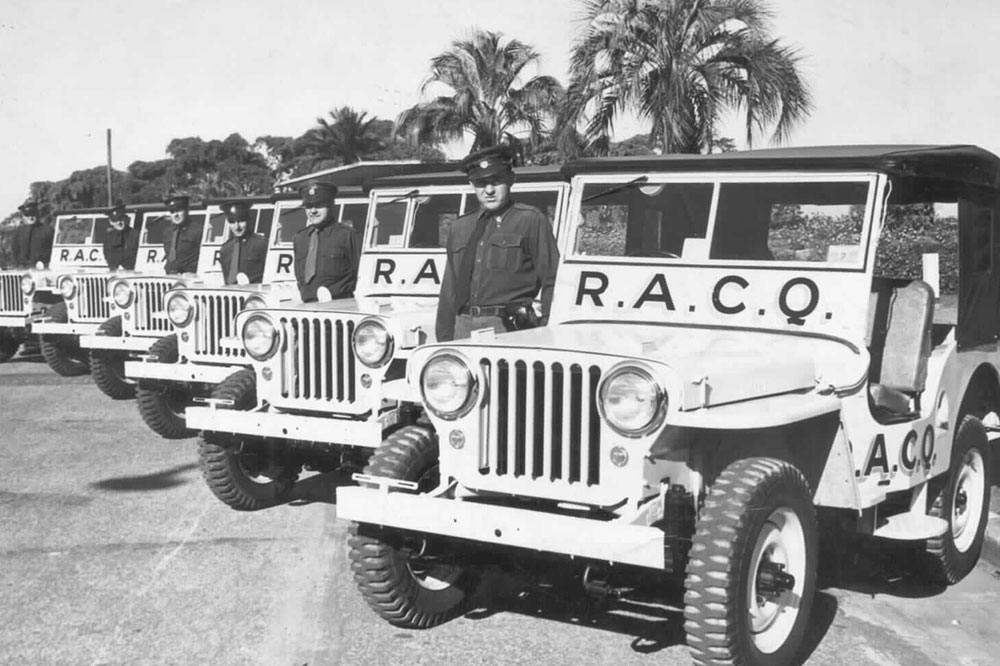Queensland’s trusted roadside partner for 100 years
A look back at significant milestones as RACQ Roadside Assistance celebrates a century of serving its members.

On 31 May 1905, 12 of Queensland's first motorists gathered at the Brisbane School of Arts to form the Automobile Club of Queensland (ACQ).
The majority of the Club's founding members were medical professionals who saw motor vehicles as a faster, more reliable way to visit patients, replacing horse-drawn buggies; 10 out of the 18 were doctors or dentists.
The club’s first president was 43-year-old Dr George Herbert Hopkins, a highly respected surgeon who had moved from the United Kingdom to Queensland in 1896. He was also elected president of the Queensland branch of the British Medical Society.
Another notable founding member was Dr Lilian Cooper, who made history as Queensland’s first registered female doctor in 1891 and the State’s first recorded female motorist.
Initially, the ACQ members would gather for regular ‘runs’ around Brisbane streets, but it didn’t take long before the club began advocating for better road conditions and other issues affecting motorists.
In 1921, the club became the Royal Automobile Club of Queensland (RACQ) after King George V granted it a royal charter, recognising the Club’s patriotic efforts during World War I. RACQ supported the war effort by organising fundraising events and helping to transport returning wounded soldiers to hospitals.
RACQ roadside service takes to the streets
Fast forward to 26 March 1925, and RACQ launched its roadside assistance service.
The Club appointed two mechanics, George Clark and Eddie Henderson, to patrol the north and south sides of Brisbane on motorcycles each Sunday, with the aim of helping stranded motorists.

A line-up of roadside patrols in 1926, including the two original members George Clarke, fourth from the left, and Eddie Henderson, fifth from the left.
The service quickly gained popularity and by September of that year, a third patrol officer was added. By November, support was limited to RACQ members due to demand, and five more officers joined the team the following year.
These early patrols carried basic tools, spare parts, fire extinguishers, and first-aid kits.
In late 1927, the service expanded beyond Brisbane after the Toowoomba branch suggested a Statewide, 24-hour roadside assistance program. The idea was approved and by 1929 RACQ had 180 listed garages across Queensland providing assistance to members.
In the 1930s, RACQ took a major step by buying its first motorcycles and sidecars, moving away from the earlier practice of patrol officers using their own motorcycles.
The fleet continued to grow throughout the 1930s, with one of these early motorcycles, a 1937 AJS, now part of RACQ's historic vehicle collection.
As demand for roadside assistance grew, RACQ extended its service hours.
By 1932, roadside assistance was available from 8:30am to 11:30pm, with patrols working shifts every day of the week.
How the service adapted during World War II
World War II brought its challenges, including a shortage of mechanics and fuel rationing.
Despite fewer vehicles on the roads, demand for roadside assistance remained high due to poor maintenance and a shortage of tyres and parts.
RACQ adapted to the challenge in 1944 and began accepting receipts from unlisted repairers when members couldn’t access approved garages.
 A motorcyle patrol converted to run on charcoal gas due to petrol shortages during World War II.
A motorcyle patrol converted to run on charcoal gas due to petrol shortages during World War II.
After the war, the roadside service continued to grow.
By 1946, uniformed patrols were introduced in Toowoomba and Rockhampton, and by 1947, they expanded to Ipswich and Townsville.
During the late 1940s, RACQ started replacing motorcycles with ex-military Jeeps, which they used into the 1950s.
In 1955, a big leap forward was made with communication when two-way radios were installed in patrol vehicles, allowing officers to communicate directly with despatchers.
Roadside service continues Queensland expansion
By this point, RACQ Roadside Assistance had expanded across Queensland, including Cairns, Mackay, Bundaberg, Maryborough, Nambour, the Gold Coast, and Warwick.
Roadside service took another major step forward in efficiency in 1987 when a computer-aided despatch system was introduced for patrols. The next evolution occurred in 1998 when a 24-hour call centre was opened at Eight Mile Plains.
From those early days, RACQ's roadside assistance service has grown into a vital part of Queensland’s motoring community, continuously developing to meet the needs of motorists.

In 1950, RACQ began using ex-military Jeeps as patrols.
This was seen most recently in 2023 when RACQ introduced an updated suite of roadside assistance products, catering for everything from e-scooters to large SUVs and caravans.
This was hailed as the biggest development in roadside assistance since George Clark and Eddie Henderson first started patrolling Brisbane’s dusty streets in 1925.
As we look to the future, the legacy of RACQ’s early pioneers continues to drive the evolution of roadside assis-tance, ensuring that no matter how the world of motoring changes, Queenslanders will always have a trusted partner on the road.
Related topics
Things to note
The information in this article has been prepared for general information purposes only and is not intended as legal advice or specific advice to any particular person. Any advice contained in the document is general advice, not intended as legal advice or professional advice and does not take into account any person’s particular circumstances. Before acting on anything based on this advice you should consider its appropriateness to you, having regard to your objectives and needs.
Insurance Products (excluding Travel Insurance) are issued by RACQ Insurance Limited ABN 50 009 704 152 (RACQI) and arranged by its agent, RACQ Distribution Services Pty Ltd (RDS) ABN 35 116 361 650, AFSL 567130 and RDS' authorised representatives (including RACQ Operations Pty Ltd ABN 80 009 663 414, AR No. 234978 (RACQO). Conditions, limits and exclusions apply. RDS and RACQO are in the RACQ group of companies. One of the companies in the RACQ group of companies has a minority shareholding in RACQI.
RDS and RACQO have not taken your personal objectives, circumstances or needs into account when preparing advice regarding insurance products and you will need to consider whether the advice is appropriate for you. Read the Product Disclosure Statement (PDS) and any applicable Supplementary PDS before making a purchase decision on this product. You can also access our Target Market Determinations on this website. RDS receives a commission from RACQI for the policies it arranges. RACQO receives fees paid for services it provides to RDS. Further details about remuneration are available on request prior to purchasing.
Banking and loan products issued by Members Banking Group Limited ABN 83 087 651 054 AFSL/Australian credit licence 241195 trading as RACQ Bank. Terms, conditions, fees, charges and lending policies apply. This is general advice only and may not be right for you. This information does not take your personal objectives, circumstances or needs into account. Read the disclosure documents for your selected product or service, including the Financial Services Guide and the Terms and Conditions, and consider if appropriate for you before deciding.
Except for RACQ Bank, any RACQ entity referred to on this page is not an authorised deposit-taking institution for the purposes of the Banking Act 1959 (Cth). That entity’s obligations do not represent deposits or other liabilities of RACQ Bank. RACQ Bank does not guarantee or otherwise provide assurance in respect of the obligations of that entity, unless noted otherwise.
RACQ Bank subscribes to the Customer Owned Banking Code of Practice which establishes higher standards than the law requires. The Code reflects modern consumer expectations and developments in approaches to issues such as consumer vulnerability, guarantors, and supporting customers through financial hardship. Please read our Customer Owned Banking Code of Practice page for more information.
RACQ Operations Pty Ltd (ABN 80 009 663 414 AR 000234978) and Members Travel Group Pty Ltd (ABN 45 144 538 803 AR 000432492) are acting as an Authorised Representative of the issuer of the insurance, Tokio Marine & Nichido Fire Insurance Co., Ltd. (ABN 80 000 438 291 AFSL 246 548). Any advice set out above is general in nature only, and does not take into account your objectives, financial situation or needs. Before purchasing any travel products, please consider the RACQ Travel Insurance Product Disclosure Statement (PDS) and the Target Market Determinations (TMDs) that apply to these products. Whilst the PDS outlines the Terms and Conditions of these products, the TMDs outline the intended class of customers that comprise the target market for these travel products. This will allow you to consider which products best suit your objectives, financial situation and needs and consider the products appropriateness to your personal circumstances. TMDs also outline matters involving the distribution and the review of these products. The PDS, Supplementary PDS and TMDs for each travel product can be found here.
